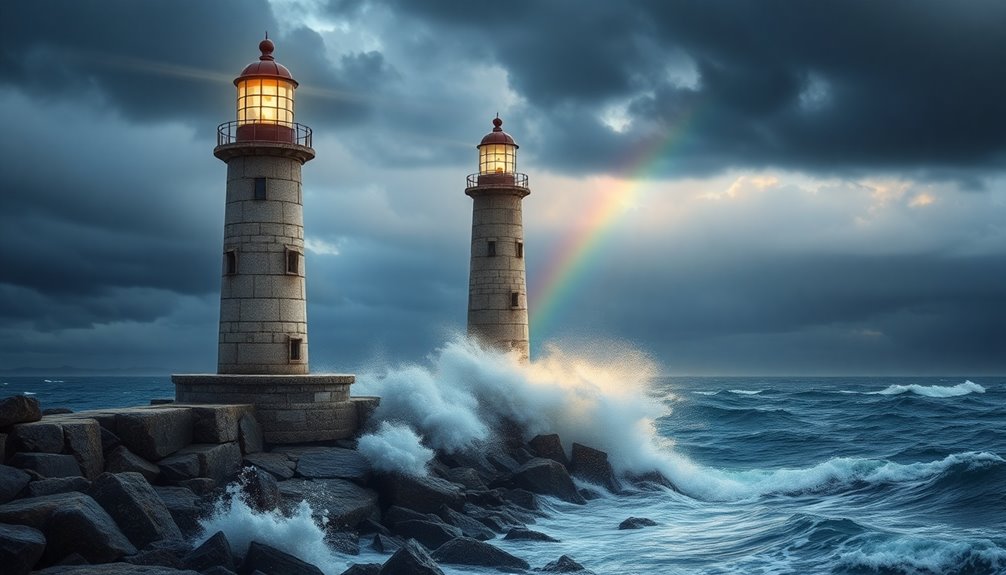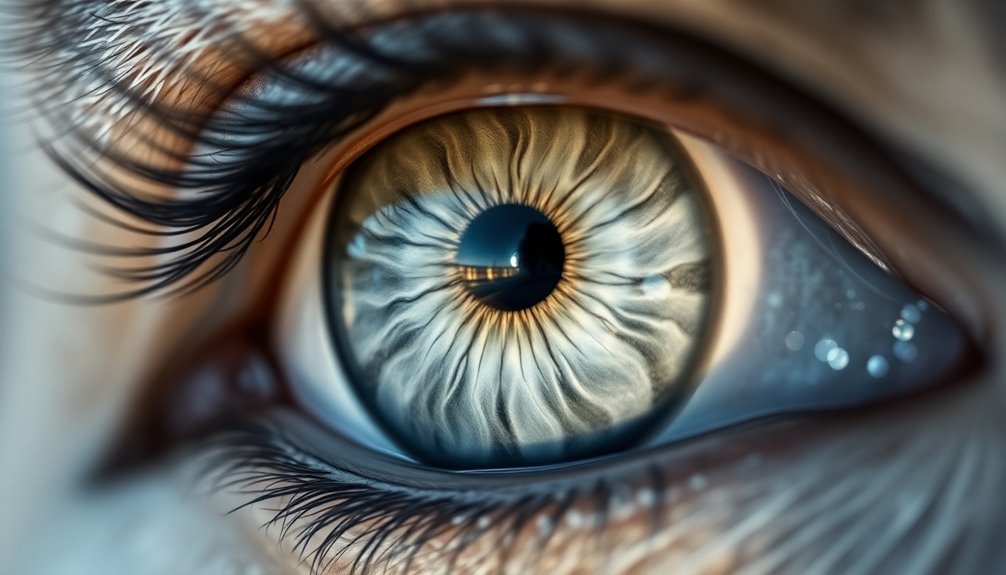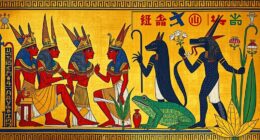Lighthouses symbolize spiritual guidance, acting as beacons of hope during life's storms. They shine a light on your path, helping you find clarity amid chaos and emotional turmoil. As you face challenges, these steadfast structures remind you of resilience and inner strength. A lighthouse encourages self-reflection and personal growth, showing that difficulties can lead to transformation. Additionally, they foster community connection, uniting people through shared experiences. Embracing the lighthouse's symbolism can nurture your spiritual journey and enhance your well-being. There's plenty more to discover about how these guiding lights can illuminate your life's path.
Key Takeaways
- Lighthouses symbolize hope, offering guidance and clarity during life's emotional storms and uncertainties.
- They represent resilience, enduring harsh conditions while inspiring personal growth and renewal.
- As navigational aids, lighthouses encourage individuals to seek higher consciousness and emotional support.
- Lighthouses foster community connections, reflecting cultural heritage and shared experiences among locals.
- Modern lighthouses utilize innovative technologies, promoting sustainability while maintaining their role as guiding lights.
Symbolism of Lighthouses

The symbolism of lighthouses embodies guidance and hope, illuminating our paths through life's uncertainties. As you face emotional storms, a lighthouse stands tall, serving as a beacon of hope. Its unwavering light reminds you that no matter how turbulent the waters, there's always a safe harbor waiting for you.
Just as sailors memorize the unique light patterns of each lighthouse for navigation, you seek distinct guidance in your spiritual journey, allowing that light to direct your steps.
Built to withstand the harshest conditions, lighthouses symbolize resilience and strength. They teach you the importance of remaining steadfast, even when life challenges you. The light they emit signifies hope and direction, much like the role of faith in providing clarity and purpose in your life.
Each lighthouse also holds a sense of community identity and heritage, fostering belonging among those who live in its shadow.
Role of Guidance

Lighthouses act as navigational reference points, reminding you to seek guidance when you face life's storms.
By tuning into higher consciousness, you can find support that fosters personal strength and resilience.
Keep in mind that guidance isn't just about avoiding pitfalls; it's also about illuminating your path toward growth and understanding.
Navigational Reference Points
Navigational reference points, like lighthouses, play a significant role in guiding sailors safely through treacherous waters. These towering structures emit unique light patterns, allowing you to recognize them from afar, ensuring you can navigate life's storms effectively.
Just as a lighthouse helps sailors identify safe passages, you need guiding lights in your life—mentors, friends, and supportive figures who help steer you toward a safe harbor. Emotional support is crucial in these times of need, providing comfort and reassurance. The profound impact of a father's role can serve as a guiding light during moments of uncertainty. Individuals facing personal challenges often benefit from effective communication strategies, which can help clarify their needs and intentions. Additionally, understanding potential dangers, such as the risks of certain foods for pets, can guide you in making safer choices for your loved ones.
Positioned strategically, lighthouses stand firm on high cliffs or coastal areas, offering visibility even in the worst weather. They remind you that reliable guidance is essential during challenging times.
When uncertainty looms and you feel lost, these guiding lights illuminate your path, enabling you to make informed decisions.
Consider the steadfast presence of a lighthouse as a symbol of hope and direction. When you face personal storms, remember that seeking guidance from those you trust can be the key to finding your way.
In times of upheaval, it's crucial to understand your legal obligations regarding child support to ensure stability for yourself and your children.
Embrace the lighthouses in your life, for they help you navigate through difficulties, leading you toward the safe harbors you seek. With their help, you can weather any storm and emerge stronger on the other side.
Higher Consciousness Awareness
When you tap into higher consciousness awareness, you're not just gaining insights; you're connecting with a deeper understanding that can transform your decision-making and personal growth. This awareness acts like a lighthouse, providing light and guidance through life's turbulent seas. As you steer through challenges, higher consciousness illuminates your path, offering hope and clarity.
By recognizing your inner light, you can overcome emotional storms, making informed choices that align with your true self. Engaging with this higher awareness encourages you to seek mentors and supportive figures who can further guide you, much like lighthouses directing ships to safety.
Here's a visual representation of how higher consciousness functions as a guiding force:
| Aspect | Description | Impact |
|---|---|---|
| Awareness | Recognizing your inner light | Enhances clarity |
| Guidance | Seeking mentors and supportive figures | Provides direction |
| Decision-Making | Making informed choices | Fosters confidence |
| Hope | Maintaining optimism in uncertainty | Inspires resilience |
| Clarity | Steering through challenges with purpose | Encourages personal growth |
Embracing higher consciousness enriches your life, helping you weather any storm with unwavering guidance.
Personal Strength Reminders
Everyone encounters challenges in life, and having a source of guidance can make all the difference. Much like lighthouses, which stand tall against storms, you too can embody strength and resilience when facing tough times. These guiding lights remind you to trust the light within, helping you navigate life's uncertainties.
When you seek guidance from mentors or spiritual figures, you're tapping into a support system tailored to your needs. Just as each lighthouse has unique light patterns, your personal guidance can illuminate your path during dark moments. This connection can empower you to stay grounded amidst chaos, and understanding the importance of emotional healing can further enhance your resilience. Additionally, engaging with natural remedies such as turmeric's anti-inflammatory properties can help alleviate physical discomfort, allowing you to focus on your emotional well-being.
Remember, lighthouses require ongoing maintenance to remain effective, just as you must cultivate your inner strength. Embrace the support around you, and let it guide you through emotional turmoil and external challenges. Engaging in practices such as journaling for self-discovery can help reinforce your sense of direction and clarity.
By standing firm and seeking direction, you can embody the steadfastness of a lighthouse, reminding yourself that you have the capacity to overcome difficulties.
In moments of doubt, reflect on the importance of having a guiding light in your life. It's this connection that will help you navigate the storms and remind you of your inherent strength.
Hope and Resilience

When you're facing dark times, think of a lighthouse shining its light through the storm.
That steady beam symbolizes hope, reminding you that you can overcome life's challenges.
Embracing this resilience can guide you toward brighter days ahead.
Light Amidst Darkness
In the midst of life's storms, lighthouses stand as powerful symbols of hope and resilience, guiding us through the darkest times. Their unwavering beams serve as the light of the world, illuminating our paths when we feel lost and overwhelmed.
Just as a lighthouse provides hope and safety to ships steering through treacherous waters, you can find your inner strength to steer through emotional turmoil and hidden fears.
When life's challenges seem insurmountable, remember that the steady light emanating from a lighthouse mirrors the resilience within you. This inner light can help you stand strong against adversity, reminding you that clarity and peace are possible even in turbulent seas.
The comforting presence of a lighthouse reassures you that storms are temporary, and perseverance will lead you to brighter days.
Every time you face darkness, think of the lighthouse, steadfast amidst the chaos. Allow its symbolism to inspire you to embrace hope and resilience, guiding you to safety and strength.
Trust that even in your darkest moments, you possess the light needed to maneuver through life's challenges and emerge stronger on the other side.
Overcoming Life's Challenges
Often, life's challenges can feel overwhelming, but embracing hope and resilience can make all the difference. Just like a lighthouse stands firm against raging storms, you too can find strength within yourself. Those steady beams of light symbolize guidance, illuminating your path during tough times. By connecting with your inner self through mindfulness practices, you can cultivate a deeper sense of peace and clarity. Additionally, embracing continuous learning can empower you to navigate life's unpredictable waters more effectively. Furthermore, engaging in effective relaxation techniques can help alleviate stress and promote emotional well-being.
When you face adversity, remember that obstacles are often opportunities for personal growth. Think of the lighthouse keepers who, despite their isolation, maintained their duties to guide ships safely through treacherous waters. Their unwavering dedication serves as a reminder that you can persevere, even when you feel alone. Also, recognizing signs of burnout can help you take proactive steps towards recovery and well-being.
By nurturing your inner strength, you can navigate your emotional storms with awareness and caution, just as a sailor relies on a lighthouse to avoid danger. Each challenge you overcome adds to your resilience, helping you become a more robust version of yourself. Embracing strategies for personal growth can also support your journey towards overcoming life's hurdles.
When you feel adrift, let the lighthouse's steady light inspire you. It's a promise that brighter days are ahead, guiding you to shore. Trust in your ability to overcome, and remember, hope can be the beacon that leads you through life's darkest moments.
Strength and Endurance

Lighthouses embody incredible strength and endurance, standing tall against the fiercest storms and relentless waves. Just like these steadfast structures, you can draw upon your inner strength to navigate the storms of life. When faced with adversity, remember that resilience is key.
Consider these three aspects of strength and endurance:
- Durability: Just as lighthouses are built from stone and brick, you can cultivate a strong foundation in your life. Develop habits and mindsets that support your well-being.
- Guidance: The constant light of a lighthouse symbolizes hope. In your darkest moments, allow that light to guide you, reminding you that you possess the strength to endure.
- Growth: The endurance of lighthouses throughout history demonstrates the potential for personal renewal. Embrace challenges as opportunities for growth and transformation.
Isolation and Self-Reflection

Standing strong against life's storms also highlights the value of isolation and self-reflection. Just like lighthouses, you can find strength in solitude. In moments of isolation, you gain the chance to engage in deep contemplation, away from the chaos that often clouds your mind. This time allows you to connect with your inner self, steering through life's challenges with clarity and purpose. Individuals facing emotional dysregulation may find that self-reflection enhances their understanding of personal experiences and promotes healing.
| Aspect | Benefits of Isolation | Encouragement for Self-Reflection |
|---|---|---|
| Clarity | Reduces distractions | Helps identify personal goals |
| Growth | Fosters personal development | Encourages emotional understanding |
| Strength | Builds resilience against challenges | Reveals inner strengths and capabilities |
| Wisdom | Provides space for insights | Enhances decision-making skills |
Community and Connection

In addition to their role as solitary beacons, lighthouses foster community and connection among those drawn to their light. They serve as gathering points that bring people together, celebrating shared experiences and love for maritime heritage.
When you visit a lighthouse, you're not just exploring a structure; you're stepping into a network of individuals who appreciate its significance.
Here are three ways lighthouses cultivate community and connection:
- Events and Festivals: Many coastal towns host events around lighthouses, allowing locals and tourists to bond over shared stories and traditions.
- Shared Reflections: When visitors come together, they often share personal stories about their experiences, creating a rich tapestry of connections that highlight the lighthouse's symbolic meaning.
- Preservation Efforts: Local volunteers work tirelessly to maintain these historic landmarks, showcasing a collective commitment to preserving cultural heritage and enhancing community pride.
Through these shared experiences, lighthouses become more than navigational aids; they transform into unifying symbols that strengthen community identity and deepen connections among residents and visitors alike.
Cultural Heritage and History

As you explore the community and connection fostered by lighthouses, you'll uncover their rich cultural heritage and history that resonate deeply with coastal communities. Lighthouses serve as cultural icons, reflecting the unique identity and pride of these areas. Each structure tells a story, showcasing the maritime history that has shaped local life for generations.
The architectural styles of lighthouses vary considerably across regions, highlighting local craftsmanship and cultural influences. For instance, the iconic Cape Hatteras Lighthouse, with its striking black and white spiral pattern, stands as a tribute to the artistry involved in lighthouse design.
Preservation efforts initiated by local communities emphasize the importance of these historic structures. By restoring and maintaining lighthouses, communities honor their maritime legacy and keep the stories of sailors alive. These efforts not only safeguard their physical presence but also serve to educate visitors about the crucial role lighthouses have played in preventing shipwrecks along treacherous coastlines.
As you visit these magnificent structures, you'll not only enjoy their picturesque beauty but also connect with the maritime heritage that continues to shape coastal identities today.
Modern Innovations

Lighthouses have embraced numerous modern innovations that enhance their functionality and sustainability. These advancements guarantee that modern lighthouses remain effective guardians of our coastlines while adapting to the challenges of today's maritime environment.
Here are three key innovations that are shaping the future of lighthouses:
- Solar Power: By utilizing solar energy, lighthouses considerably reduce their reliance on traditional energy sources, making them more eco-friendly and sustainable.
- LED Lighting: The shift to LED lighting provides brighter and more efficient illumination, improving visibility for ships steering through treacherous waters.
- Automated Systems: Modern lighthouses now incorporate automated systems for remote monitoring, which decreases the need for constant human presence, guaranteeing that these structures operate smoothly and efficiently.
As technology evolves, maintenance practices have also improved, employing advanced materials and engineering solutions to withstand harsh weather conditions. Additionally, the integration of solar charge controllers enhances the efficiency of the solar energy systems used in these lighthouses.
Furthermore, continuous updates to navigational technologies keep lighthouses relevant and effective, adapting to the ever-changing maritime landscape shaped by climate change and increased shipping traffic.
These innovations not only enhance safety but also guarantee that lighthouses continue to shine brightly as symbols of guidance and security.
Spiritual Growth and Enlightenment

Many people find that the symbolism of lighthouses resonates deeply with their journey toward spiritual growth and enlightenment. Just like a lighthouse cutting through the fog, your path to wisdom shines bright amidst life's challenges. The steady light of a lighthouse serves as a reminder that clarity and guidance are always within reach, especially when you're steering through emotional or spiritual turmoil.
Here's a table to help you reflect on the aspects of spiritual growth:
| Aspect | Lighthouse Symbolism | Application in Life |
|---|---|---|
| Guidance | Illuminating safe passages | Seeking clarity in decisions |
| Resilience | Withstanding storms | Persevering through adversity |
| Introspection | Exploring inner light | Engaging in self-discovery |
| Wisdom | Path to self-actualization | Gaining insights |
| Peace | Steering through turmoil | Achieving personal peace |
In the Bible, light symbolizes hope and guidance, echoing the role of lighthouses in your spiritual journey. Embrace this symbolism, and remember to harness your inner light as you steer through the storms of life.
Frequently Asked Questions
What Does the Lighthouse in the Storm Mean?
When you think about a lighthouse in a storm, it represents guidance and hope.
It stands tall amidst chaos, showing you the way through life's turbulent moments. The lighthouse's steady light helps you navigate challenges and avoid potential dangers.
It reminds you to hold onto your values and inner strength, even when the storms rage around you. Like a beacon, it emphasizes the importance of finding clear direction and support during tough times.
How Does a Lighthouse Warn People?
Ever thought about how a lighthouse is basically nature's version of a flashing neon sign? It warns you with distinct light patterns—like it's doing a little dance to grab your attention.
You can spot it from up to 21 nautical miles away, which is pretty impressive! It even adds sound signals for those foggy days when you might be squinting at the horizon.
What Does the Lighthouse Symbolize in the Bible?
In the Bible, the lighthouse symbolizes Jesus as the "Light of the World," guiding you through life's uncertainties.
Just like a lighthouse offers navigational aid, Jesus provides wisdom and direction when you face challenges. The steadfast nature of lighthouses reflects His unwavering strength, reminding you that He's a firm foundation during tough times.
Each unique light pattern serves as a reminder of His distinct teachings, illuminating your path in times of need.
Why Is a Lighthouse a Symbol of Hope?
A lighthouse symbolizes hope because it stands tall against storms, offering a steady light when darkness surrounds you.
When you feel lost or overwhelmed, a lighthouse reminds you that safety and direction are always available. Its unwavering presence assures you that challenges can be faced and overcome.
Just like a lighthouse guides ships home, it inspires you to keep moving forward, knowing there's a path through even the roughest seas of life.
Conclusion
In the swirling tides of life, the lighthouse stands as your steadfast beacon, illuminating the path through stormy seas. It whispers of hope, urging you to embrace resilience and seek shelter in moments of isolation. As you navigate your journey, remember that each wave carries the wisdom of connection and community. Let the light guide your spirit toward growth and enlightenment, transforming life's tempests into opportunities for discovery. Trust in your inner lighthouse, and you'll always find your way home.











